Hafa Adai from Saipan!
Hafa Adai is pronounced "half a day", which expats
joke is the amount of work you get from a full day's
pay from Chamorro workers. (Or in our experience, the
amount of time it takes to check in while paying
overtime charges.)
We had a pleasant 6 day passage from Pohnpei with
pretty ideal weather. Landfall was pretty uneventful
until we got into port. The marine police boat
requested we follow them into the uncharted inner
harbor to check in. One quarter of the way down the
channel, we wacked the keel on a rock in the center of
the channel while following the police boat as
instructed. Garth crashed against something sharp on
the dodger and blood gushed from a slice on his ear.
We'd been going dead slow, or so we thought. We
turned around pronto. The police boat came back out
and asked why we had stopped following. When we told
them we'd hit a rock in the center of the channel,
they said that we should have hugged the left side of
the channel. Thanks for the helpful info! (The keel
damage was only surface scratches, and Garth's bloody
ear healed in a couple days. Later we found a crack
in a bulkhead where the life raft had smashed against
it on impact, but we were able to epoxy it without any
further problem.)
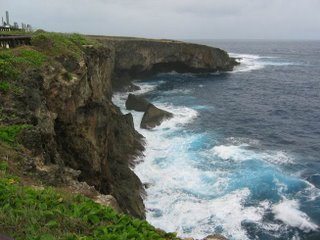
But we still had to check in. The Marine Police
suggested we tie up to a really gnarly dock to check
in. We decided to anchor and back in to avoid
scratching up the boat against this rusty ship's pier.
As we dropped the anchor, the engine died, making for
a stressful situation until the anchor grabbed and we
got lines to shore. Adding to the pressure was an
immigration guy requesting our passports before we
even finished tying up. ("Can't you see we're not
even stopped yet?") We waited for hours, holding the
boat off shredded black tires and rusty broken
supports, while each of the officials came to check us
in. They were very officious with a volume of
paperwork to keep government workers busy filing for a
long time. We just about died when they told us the
fees amounted to more than $200. The overtime charges
were a tiny fraction of the fees since wages are so
low here in this American outpost. (We've never paid
fees this high anywhere in the many countries we've
visited by boat.) We later learned that the best jobs
are working for the government and nearly everyone on
Saipan does.

Once we got over the trauma of our unpleasant arrival
we have really loved Saipan. We have found everyone
we've met to be extremely friendly and welcoming. The
"Seattle, WA" painted on the side of our boat has
garnered lots of attention and curiosity. We have
had numerous visitors to our boat and offers of tools,
rides, showers, laundry, social invitations, etc.
We've been docked in an ideal situation, on a new dock
with power and potable water, right next to a
beautiful park with pine trees and turquoise water.
Fees are $4 per day. Town is a block away across the
park, and we have several Japanese World War II
bunkers within a few hundred yards of the boat. The
marina staff is extremely friendly, efficient and
helpful. They've gone out of their way to make our
stay a pleasant one, offering to arrange for
transportation, dive equipment, free email access on
their computers plus wifi hookup for using our own, as
well as inviting us to join them for meals and
parties. We joined them for a picnic where we got to
check out some neat Chamorro foods and a fermented
coconut drink called Tuba, which was tasty when cold,
but a little less smooth when it warmed up.

As we wandered about town, we've marveled at the
multitude of ethnic restaurants (Thai, Vietnamese,
Japanese, Korean, Filipino, Chamorro, Indian), massage
parlors and poker rooms serving far fewer tourists
than such an infrastructure is designed to support.
And the buildings' veneers are starting to show signs
of decline. The dramatic drop in tourism started by
the Asian economic bust has never really recovered,
particularly after the Chamorro government tried
greedily to price gauge when things began to pick up
again. Tourism, once made up of mostly big spending
Japanese, has changed. As more Chinese and Koreans
visit, the flavor of tourism is more budget and chases
the Japanese luxury traveler away. But there are
still some fine hotels where we can relish the
luxurious life.
The streets are nearly empty during the day but become
busier at night when the tourists leave the beach to
explore town and dine. If we thought the shopping and
restaurants were a treat in Pohnpei after Kwaj, you
can imagine how excited we were in Saipan, where
there's 20 times the variety! The town is spread out
mostly along a single long road along the water, and
we have really appreciated being able to borrow bikes,
as they have expanded our horizons significantly. A
great bike path runs along most of the western
waterfront, and we have made extensive use of it.
Along the beach we see an amusing array of outrigger
canoes formulated from the oddest assortment of raw
materials: old sailboats and rowing boats with PVC
piping forming the outriggers, old jet ski hulls cut
out, and an assortment of Hobie cat hulls. Not sure
whether anyone gains anything from these odd
outriggers, but they seem to be essential.
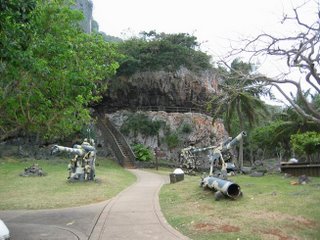
One of the treats of Saipan is that we have been able
to meet up with friends here. Brian Smith, a fellow
cruiser that visited us in Kwaj a year ago is here
working as a Mechanical Engineer for the government's
public works department. He has shown us so much more
that we'd have seen on our own. Together we have gone
boonie stomping every weekend through remote trails,
around numerous caves and old war ruins far off the
beaten path. We have seen old bones, zillions of sake
bottles, Japanese pottery, and war relics. We've
collected quite a bit of red dirt on our shoes as
we've tromped through narrow paths in the jungle that
a machete cleared only recently.
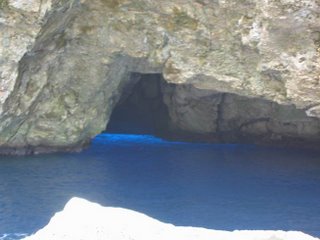
We've also been fortunate to coordinate visits with a
few teacher friends on spring break from Kwaj and my
(Wendy's) father. An impressive World War II museum
is situated directly between the boat and Dad's hotel
room, which we've visited repeatedly to better
understand the battles of the Pacific, fought in many
of the places we've voyaged and some we have yet to
see. With its exhibits, great films on display and a
gift store full of books, the museum was a continual
source of information and entertainment (plus
bathrooms, drinking water and A/C!) throughout our
visit.
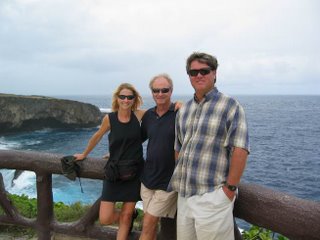
With our friends during their short visit, besides
shopping, eating well, and catching up, we did some
exploring. We rented two cars and convoyed to see the
last command post the Japanese soldiers held here on
Saipan, as well as the heartbreaking sites of Bonzai
and Suicide Cliffs where Japanese families jumped and
pushed their children to their deaths, to avoid
capture and torture by the Americans as they had been
taught to fear. (Following the First World War,
Saipan had become a large sugar cane farming
settlement of more than 10,000 Japanese and many
stayed on through the World War II.) By rental car,
we also visited some beautiful scenic overlooks, such
as bird rocks and an incredible grotto that we later
investigated with scuba gear. And we explored several
of the thousands of natural and enhanced caves where
soldiers and families hid during the fighting. With
Brian and my dad we revisited these areas a number of
times.
Brian treated us to an afternoon/evening with the
local chapter of the Hash House Harriers (a running
club with a drinking problem or a drinking club with a
running problem, depending on the local flavor). The
club has groups all over the world, especially in
places where the British have been. Fortunately
hiking instead of running is allowed, particularly as
this was some serious boonie stomping, a course cut
through the jungle not easily run by a newbie. The
courses are set in advance by 2 hares, who then mark
the trail at the last minute with flour clues and
sometimes false trail leads. They get a 10 minute
head start, after which they are pursued by the rest
of the group. If they are caught, they lose their
shorts, literally! We all set off to find our way to
the end, where the beer truck will be waiting. Gotta
hike/run the trail to get to the beer truck.
The Hash was a hot, sweaty, but fun business. As
everyone gathers at the ending point, beers are passed
around and the antics really begin. Like a
fraternity, there are songs and jokes, nicknames, an
initiation ceremony and, of course, lots of beer
drinking. As FNG's (F'ing New Guy),we were prime
candidates for initiation which involves drinking (or
wearing - our choice) cheap beer from a stainless
urinal. Another big part of the tradition is coming
up with nicknames, something we were pretty excited
about since they were all so flattering. With names
like: "Drool Bag", "Donkey Dick", "Hand Job", "Dog
Leg", "Happy Pockets", "Short Time", "Second Coming",
"Vertical Lay", "Oly" and "Max Cheesmo", we could
hardly wait to see what gem they might come up with
for each of us. Briefly they toyed with "Heini
Kicker" or "Kick your Heini" since I'd kicked over a
can of Heiniken (I was set up!), but it didn't stick.
After much beer drinking, jokes and a bonfire, the
group relocated to a favorite bar. And the Harriers
do this every week!
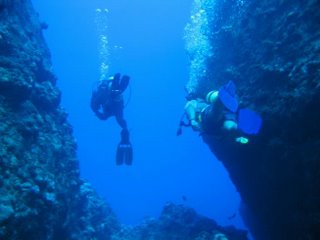
We returned to the Grotto for a more in depth
exploration with dive gear. One hundred and twenty
steep steps down and then back up again with full dive
gear is not for the faint of heart, but we were well
rewarded for our efforts. At the base of the steps we
timed our venture across the gap to a rock island from
which we could jump off into deep water. (And getting
back out of the water, it was a challenge to avoid
getting swept in the gushing water through that same
gap.) The water clarity was impressive. Sunlight
shines through the blue water from tunnels in the rock
between the huge cave and the sea outside. We
explored several inlets inside the grotto cave, then
swam through one of these openings to the sea outside,
explored outside for a bit, then returned to the
grotto through another opening. Upon our return, this
local swimming hole was filled with Chamorros enjoying
a Sunday outing with snorkel gear. And as we were
exiting the water with our rubber legs, a group of 12
tourists arrived in full dive gear. Nearly deserted
in all our previous visits, the grotto is a popular
place on a Sunday afternoon! As I climbed the steps
in my full dive gear, I was asked to pose with each of
3 Chinese gals.

My father and I took a ferry to the nearby island of
Tinian, where the atomic bombs were loaded for their
secret missions of destruction that brought about the
end of the War in the Pacific. We saw bomb pit one,
where "Little Boy" was loaded into the Enola Gay
before it made its historic impact on Hiroshima. And
we saw bomb pit two, where "Fat Man" was loaded and
exploded over Nagasaki after weather forced a change
of destination cities. We also saw the huge airfield
used by both Japanese and American forces and an
incredible number of Japanese buildings, facilities
and bunkers, many still in excellent shape, including
an underground fuel depot, a power plant, a radio
communication building, and the air administration
building where three Japanese soldiers were found
after committing ritual Hara Kiri. We saw another
Suicide Cliff where some of the 19,000 Japanese sugar
cane farmers on Tinian jumped to their deaths. A
number of monuments commemorate those who died. Three
Chinese were recently caught in the act of defacing
one of the Japanese monuments and other monuments have
also suffered from vandalism in recent months.
Whereas photos of Tinian prior to the war show
Japanese towns and thousands of plots of land under
cultivation, now only about 3000 Chamorros live in
open countryside. A couple of casinos lure tourists
to Tinian to gamble, but otherwise it is a sleepy
place, famous only for its role in history.
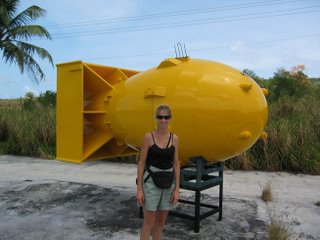
A regular Thursday street fair offers countless
delectable meals and snacks from the many ethnicities
that populate Saipan. After a week and a half in
Saipan, we began to recognize people from around town
who would convene for this popular event. Each week
features entertainment and we got to see dances from
Palauan, Thai and Chuukese women and then an
incredible performance of a Japanese drumming dance
troupe that gave it everything they had. Much of the
charm of Saipan is its interesting mixture of
cultures, with Chinese, Filipino, American, Thai,
Japanese and Korean coming together.
While we are very tempted to stay much longer in this
delightful place, typhoon season is approaching and we
need to make tracks to a safer haven with enough time
to see some places along the way.
Cheers,
Wendy Hinman and Garth Wilcox
S/V Velella (Wylie 31)

<< Home